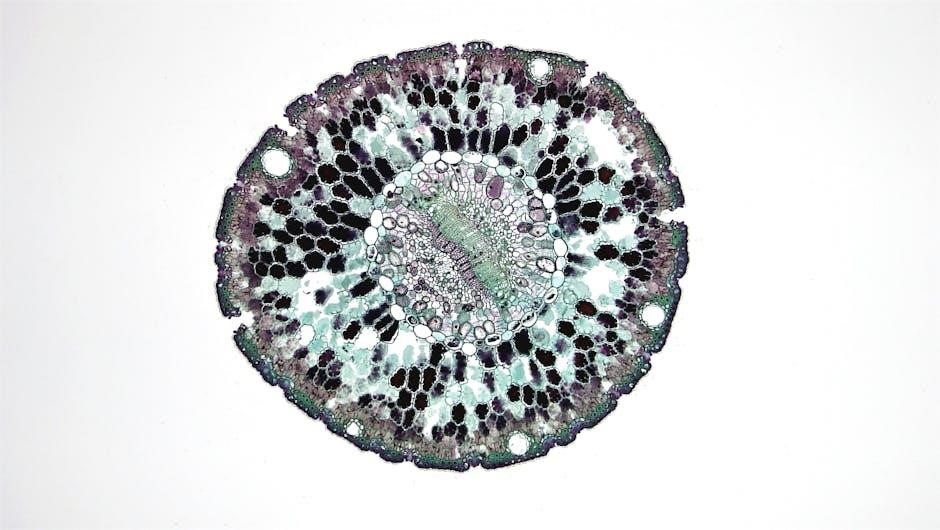Cellular transport is the process by which molecules move across cell membranes, essential for maintaining cellular function and homeostasis. It involves passive and active mechanisms, including diffusion, osmosis, and energy-dependent transport, crucial for nutrient uptake, waste removal, and signaling. Understanding these processes is fundamental to biology and medicine, offering insights into cellular health and disease.
1.1 Importance of Cellular Transport in Biological Systems
Cellular transport is vital for maintaining life, enabling cells to acquire essential nutrients, expel waste, and regulate internal conditions. It ensures proper ion balance, supports metabolic functions, and facilitates communication between cells. Disruptions in transport mechanisms can lead to cellular dysfunction and disease, emphasizing its critical role in biological systems and overall organismal health.
1.2 Overview of Key Concepts and Processes
Cellular transport involves movement of molecules across membranes via passive and active mechanisms. Passive transport includes diffusion, facilitated diffusion, and osmosis, relying on concentration gradients. Active transport requires energy, often involving pumps, to move molecules against gradients. These processes are fundamental for cellular function, enabling nutrient uptake, waste removal, and maintaining internal balance, as highlighted in various studies and guides on cellular biology and biochemistry.

Types of Cellular Transport
Cellular transport is categorized into passive and active transport. Passive transport involves movement down concentration gradients without energy, while active transport requires energy to move molecules against gradients, enabling essential cellular functions and maintaining homeostasis. These processes are vital for nutrient uptake, waste removal, and cellular signaling, as discussed in various biological studies and educational resources.
2.1 Passive Transport
Passive transport is the movement of molecules across cell membranes without energy input, driven by concentration gradients. It includes simple diffusion, facilitated diffusion, and osmosis. Simple diffusion involves molecules moving directly through the lipid bilayer, while facilitated diffusion uses transport proteins. Osmosis is the diffusion of water across the membrane, crucial for maintaining cell turgidity. These processes are essential for cellular equilibrium and nutrient distribution, as highlighted in recent studies on membrane dynamics and molecular movement.
2.2 Active Transport
Active transport is an energy-consuming process moving molecules against concentration gradients, requiring ATP and transport proteins. It is vital for maintaining cellular homeostasis, enabling cells to accumulate essential nutrients and ions. For example, sodium-potassium pumps use ATP to regulate ion balance, crucial for nerve signaling. Recent research highlights its role in disease treatment, such as drug delivery mechanisms targeting specific transporters, emphasizing its importance in medical interventions and cellular regulation.

Passive Transport Mechanisms
Passive transport involves the movement of molecules without energy input, driven by concentration gradients. It includes diffusion, osmosis, and facilitated diffusion, essential for cellular equilibrium and substance exchange.
3.1 Simple Diffusion
Simple diffusion is the passive movement of molecules from a high to low concentration area across the cell membrane without the need for proteins. This process is driven by kinetic energy and thermodynamic forces, allowing substances like oxygen and carbon dioxide to enter or exit cells efficiently. It is a fundamental mechanism for maintaining cellular homeostasis and energy balance.
3.2 Facilitated Diffusion
Facilitated diffusion involves the movement of molecules across the cell membrane with the assistance of transport proteins. These proteins, such as channels or carrier proteins, enable substances like glucose and ions to cross the membrane down their concentration gradient. This process is passive, requiring no energy, and is essential for cells to acquire nutrients and maintain proper ion balances efficiently.
3.3 Osmosis
Osmosis is the passive transport of water molecules across a semipermeable membrane from an area of low solute concentration to an area of high solute concentration. This process helps regulate cell shape, turgor pressure, and internal environment. Osmosis is crucial for cellular functions such as maintaining fluid balance and enabling nutrient uptake, particularly in plant cells where it supports water absorption and stomatal regulation.
Active Transport Mechanisms
Active transport requires energy, often in the form of ATP, to move molecules against their concentration gradient. It involves transport proteins and is crucial for cellular functions.
4.1 Energy-Dependent Transport
Energy-dependent transport, a type of active transport, relies on ATP to move molecules against concentration gradients. This process is vital for cellular functions like ion pumping and nutrient absorption. Transport proteins, such as pumps and carriers, facilitate this movement, ensuring essential molecules are transported into or out of cells, maintaining cellular homeostasis. This mechanism is crucial for various biological processes and systems.
4.2 Role of Transport Proteins
Transport proteins play a crucial role in facilitating the movement of molecules across cell membranes. These proteins, including carriers and pumps, enable both passive and active transport by binding to specific molecules. They regulate the passage of ions, nutrients, and waste products, ensuring proper cellular function. Their structure and function are essential for maintaining concentration gradients and cellular homeostasis, making them indispensable in various biological systems and processes.

Cellular Transport and the Cell Membrane
The cell membrane’s structure enables selective permeability, regulating molecular movement through passive and active transport mechanisms, ensuring proper cellular function and maintaining internal homeostasis.
5.1 Structure and Function of the Plasma Membrane
The plasma membrane is a dynamic, semi-permeable bilayer of phospholipids with embedded proteins, facilitating cellular transport. Its fluid mosaic model allows for selective permeability, enabling the movement of essential molecules while restricting others. This structure is vital for maintaining cellular homeostasis, regulating the exchange of nutrients, waste, and signaling molecules, ensuring proper cellular function and overall organismal health.
5.2 Membrane Permeability and Selectivity
Membrane permeability refers to the ability of substances to pass through the plasma membrane, governed by its semi-permeable nature. Selectivity ensures that only specific molecules, based on size, charge, and lipid solubility, are transported. This regulation is crucial for maintaining cellular homeostasis, allowing essential nutrients to enter while restricting harmful substances. Transport occurs via passive diffusion or active mechanisms, guided by concentration gradients and membrane proteins.

Regulation of Cellular Transport
Cellular transport is regulated by concentration gradients, membrane proteins, and environmental factors, enabling cells to adjust to internal and external changes while maintaining homeostasis and proper function.
6.1 Concentration Gradients and Their Role
Concentration gradients are essential for cellular transport, driving passive processes like diffusion and osmosis. They determine the direction of molecule movement, from high to low concentration, enabling cells to maintain balance. Gradients are crucial for nutrient uptake and waste removal, ensuring proper cellular function and survival by regulating the flow of substances across membranes efficiently and effectively.
6.2 Influence of Environmental Factors
Environmental factors significantly impact cellular transport, affecting membrane permeability and transport efficiency. Temperature alters membrane fluidity, influencing diffusion rates, while pH changes can disrupt protein function. Additionally, external solute concentrations modify osmotic pressures, affecting water and ion movement. These factors highlight the dynamic interplay between cells and their surroundings, crucial for maintaining homeostasis and ensuring proper cellular function under varying conditions and stress.

Applications and Implications of Cellular Transport
Cellular transport advances medicine, enabling drug delivery and therapeutic interventions. It also drives biotechnology, aiding in gene transfer and industrial processes, while inspiring innovative solutions across scientific fields.
7;1 Medical Applications and Therapeutic Interventions
Medical applications of cellular transport include targeted drug delivery systems, enhancing therapeutic efficacy while reducing side effects. Researchers utilize transport mechanisms to develop treatments for chronic diseases, such as gene therapy and cancer treatments. Understanding transport processes aids in combating pathogens, like HIV, which hijack cellular systems. These advancements pave the way for innovative, life-saving interventions.
7.2 Industrial and Biotechnological Uses
Industrial applications leverage cellular transport for biofuel production, waste management, and bioremediation. Biotechnology harnesses transport mechanisms to optimize drug synthesis and food processing. Advanced membrane technologies mimic cellular transport for water purification and chemical separation. These innovations enhance efficiency, sustainability, and scalability in various industries, driving economic growth and environmental solutions.

Study Tips and Resources for Understanding Cellular Transport
Mastering cellular transport requires interactive learning tools, such as diagrams and videos. Utilize practice quizzes, flashcards, and study guides for better retention. Explore textbooks and online courses for comprehensive insights.
8.1 Effective Learning Strategies
Engage with interactive tools like diffusion simulations and membrane model kits to visualize processes; Create concept maps linking transport types, mechanisms, and cellular functions. Practice with past exam questions and flashcards to reinforce key terms. Teach concepts to others to deepen understanding. Regular review and active participation in discussions enhance retention and clarify doubts effectively.
8.2 Recommended Study Materials and Tools
Utilize textbooks like “Biology: The Core” for detailed explanations. Explore online platforms such as Khan Academy and Coursera for video tutorials. Interactive simulations from PhET and Labster enhance conceptual understanding. Download mobile apps like Quizlet for flashcards and Biology Dictionary for terminology. Engage with lab simulations to visualize transport processes. Supplement with study guides and past exam papers for comprehensive preparation.
Common Misconceptions About Cellular Transport
Clarifying myths: passive transport isn’t always simple diffusion; active transport doesn’t always require ATP. Misunderstandings about concentration gradients and energy use are prevalent, requiring careful clarification.
9.1 Clarifying Frequently Misunderstood Concepts
A common misconception is that all passive transport is simple diffusion; facilitated diffusion also exists. Active transport doesn’t always require ATP directly but uses energy indirectly. Concentration gradients don’t always dictate transport direction, as some processes counteract them. Membrane structure plays a crucial role, but it’s not the sole factor in transport mechanisms. Understanding these clarifies misunderstandings about cellular transport efficiency and regulation.
9.2 Addressing Myths and Misconceptions
Contrary to popular belief, osmosis isn’t limited to water; it involves any solute-free movement across membranes. Active transport doesn’t always move molecules against gradients; it can also maintain them. Additionally, the cell membrane isn’t impermeable but selectively allows certain molecules, debunking the myth of a static barrier. These clarifications enhance understanding of cellular transport dynamics and membrane functionality in various biological systems and processes.
Advanced Topics in Cellular Transport
Exploring macromolecular crowding and biomolecular condensates reveals how cellular environments influence transport dynamics. These emerging topics highlight the complexity of intracellular organization and its impact on molecular movement.
10.1 Emerging Research and Discoveries
Recent studies explore macromolecular crowding’s role in regulating intracellular transport, mimicking real-world cellular environments. This research reveals how crowded conditions influence molecular movement, offering new insights into cellular organization. Additionally, advancements in understanding biomolecular condensates—membrane-free droplets coordinating key cellular processes—highlight their significance in transport dynamics. These findings open doors to understanding complex cellular behaviors and their implications for biotechnology and medicine.
10.2 Future Directions in the Field
Future research in cellular transport may focus on exploring macromolecular crowding’s potential to enhance drug delivery systems and understand biomolecular condensates’ role in disease mechanisms. Advances in gene transfer technologies could revolutionize treatments for chronic illnesses. Additionally, studying transport dynamics at nanoscales may uncover new therapeutic targets, offering innovative solutions in medicine and biotechnology while deepening our understanding of cellular organization and function.
Case Studies and Real-World Examples
Real-world examples include gene transfer ameliorating chronic diseases and HIV hijacking cellular transport. These studies highlight the significance of transport processes in medicine and research.
11.1 Practical Applications in Medicine and Biology
Gene transfer techniques leverage cellular transport to treat chronic diseases, enhancing healing processes. Researchers study how HIV hijacks cell transport systems, offering insights into viral mechanisms. These applications underscore the critical role of transport processes in medical advancements and therapeutic interventions, bridging biology and medicine for innovative solutions.
11.2 Historical and Contemporary Research Highlights
Historically, studies on cellular transport have revealed key mechanisms like diffusion and active transport. Recent advancements include research on macromolecular crowding’s role in intracellular transport, published in 2019, and Muniswamy’s insights into cellular magnesium transport. Contemporary studies also explore how HIV hijacks cellular transport systems, providing deeper understanding of viral mechanisms and their implications for medical interventions.
Cellular transport is essential for life, enabling nutrient uptake and waste removal. Understanding its mechanisms, from passive diffusion to active transport, is crucial for advancing biology and medicine.
12.1 Summary of Key Takeaways
Cellular transport is vital for maintaining life, enabling the movement of essential molecules. Key mechanisms include passive transport, such as diffusion and osmosis, and active transport, requiring energy. Understanding these processes is crucial for grasping cellular function, disease mechanisms, and therapeutic interventions. Mastery of these concepts aids in advancing biological knowledge and practical applications in medicine and biotechnology.
12.2 Encouragement for Further Exploration
Exploring cellular transport opens doors to understanding life’s fundamental processes. Delve into real-world applications, cutting-edge research, and practical experiments to deepen your knowledge. Engage with scientific articles, online courses, and lab simulations to enhance your learning. Embrace curiosity and pursue advanced topics, as cellular transport holds the key to innovations in medicine, biotechnology, and beyond. Keep exploring—discoveries await!
